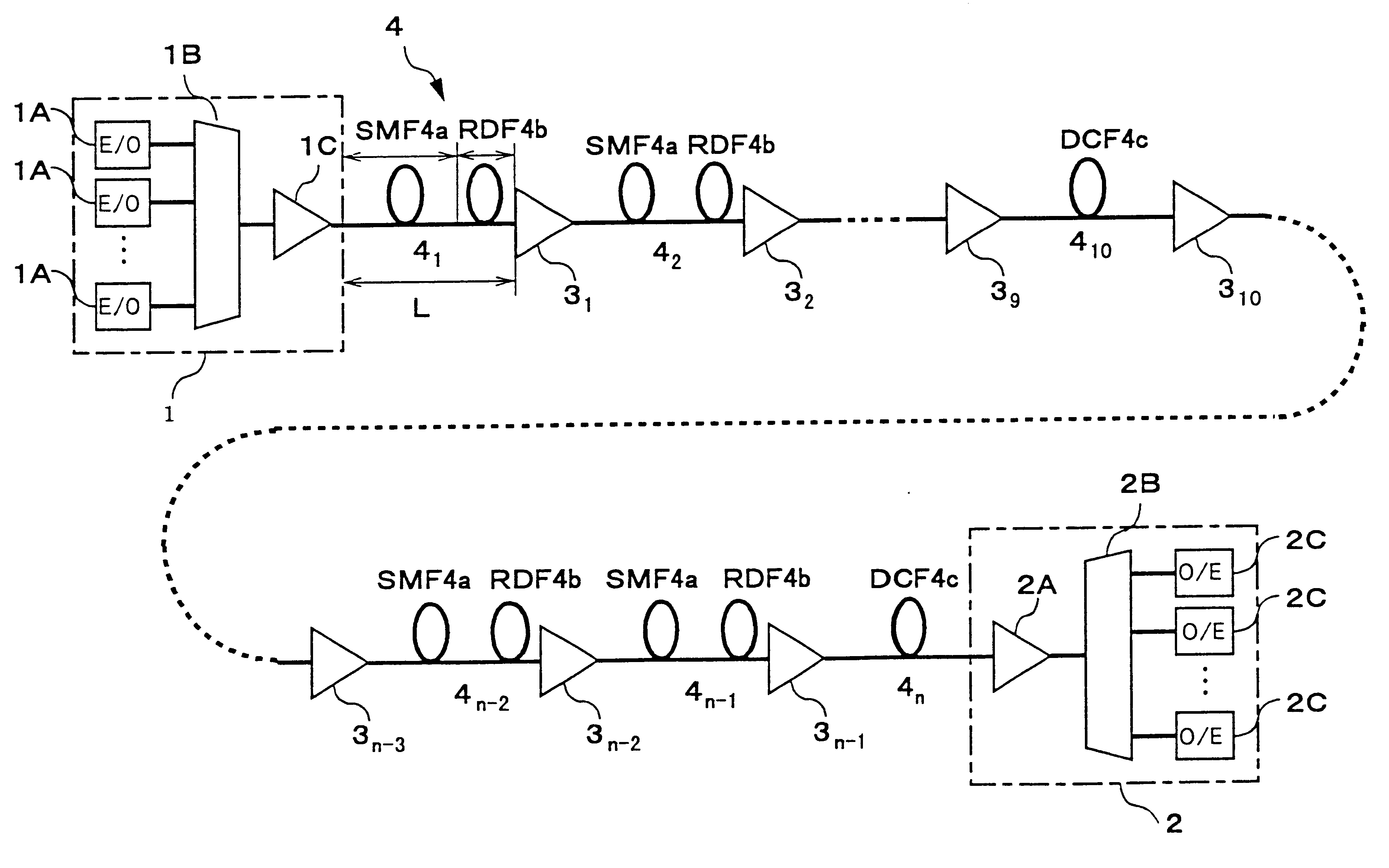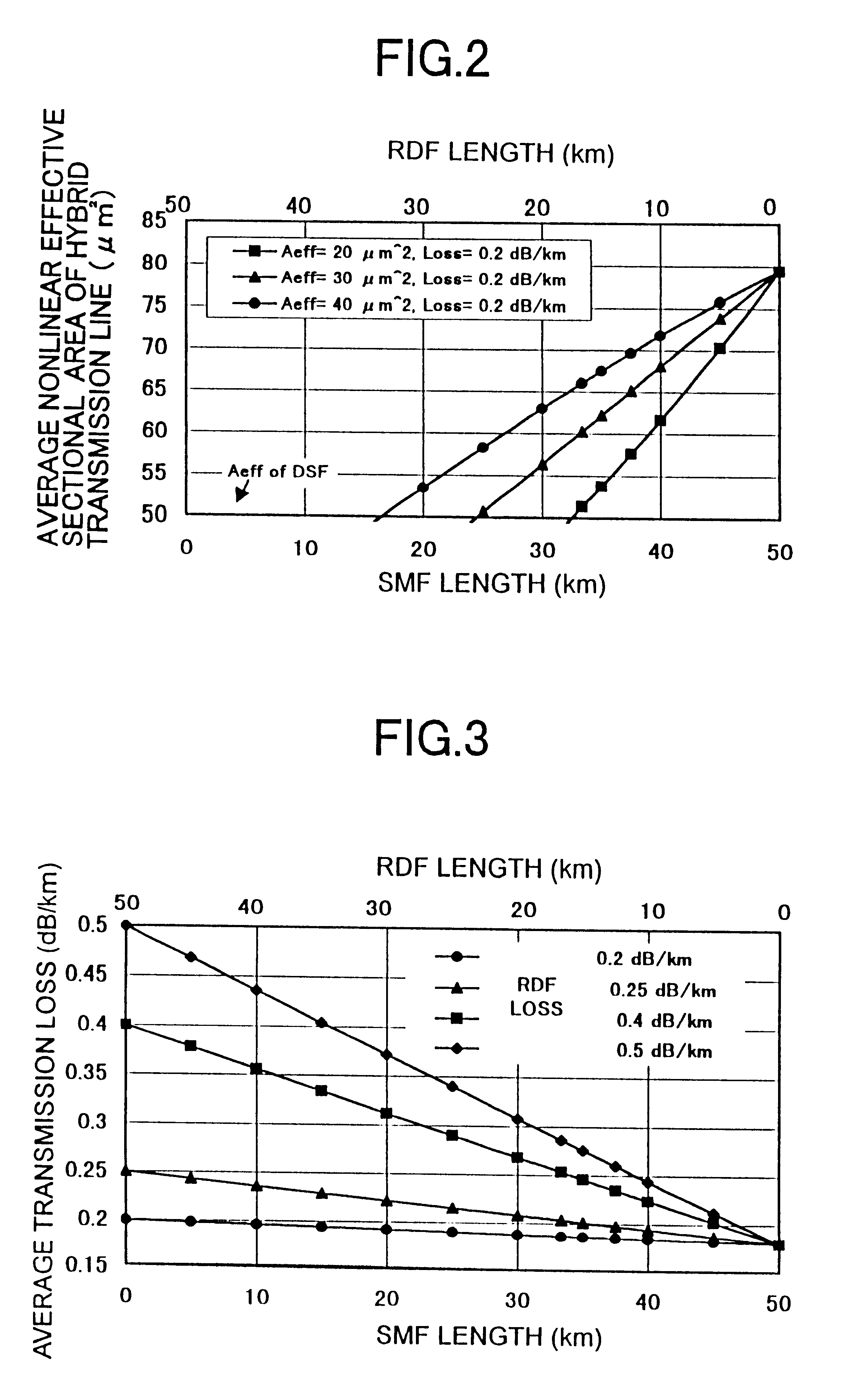Wavelength division multiplexing optical transmission system
a transmission system and optical transmission technology, applied in the field of wavelength division multiplexing optical transmission system, can solve the problems of weak signal light waveform, nonlinear effect, and low wavelength dispersion,
- Summary
- Abstract
- Description
- Claims
- Application Information
AI Technical Summary
Problems solved by technology
Method used
Image
Examples
first embodiment
FIG. 1 is a block diagram showing a basic configuration of a WDM optical transmission system in accordance with a
The WDM optical transmission system shown in FIG. 1 consists of, for example, an optical transmitter station 1, an optical receiver station 2, a plurality of optical amplifiers (optical repeaters) 3.sub.1, 3.sub.2, etc., and an optical fiber transmission line 4. The plurality of optical amplifiers is arranged between the transmitter and receiver stations at required intervals. The optical fiber transmission line 4 links the optical transmitter station 1, the respective optical amplifiers 3.sub.1, 3.sub.2, etc., and the optical receiver station 2.
The optical transmitter station 1 includes a plurality of optical transmitters (E / O) 1A, a multiplexer 1B, and a post-amplifier 1C. The plurality of optical transmitters (E / O) 1A outputs a plurality of optical signals having different wavelengths. The multiplexer 1B wavelength division multiplexes the plurality of optical signals ...
second embodiment
Next, the present invention will be described below.
In the aforesaid first embodiment, cumulative wavelength dispersion generated in each hybrid transmission line is compensated for at required compensation intervals such as ten spans, and thus converged to nearly zero. However, according to this method of compensating for cumulative wavelength dispersion, similarly to the conventional method described in conjunction with FIG. 19, a state in which cumulative wavelength dispersion becomes positive is repeated periodically. When cumulative wavelength dispersion becomes positive, the peak value of optical power increases due to effect of optical pulse compression, to thereby become susceptible to a nonlinear effect. In the second embodiment, by taking a countermeasure in order to always keep cumulative wavelength dispersion negative, the nonlinear effect is prevented from being generated to thereby improve a transmission characteristic.
FIG. 11 is a block diagram showing a basic configu...
third embodiment
Next, the present invention will be described below.
According to a WDM optical transmission system in accordance with the third embodiment, residual wavelength dispersion-slope that could not be compensated for by the optical fiber transmission line 4 in the aforesaid embodiments is compensated for to thereby further improve a transmission characteristic.
FIG. 14 is a block diagram showing a schematic configuration of a WDM optical transmission system of the third embodiment.
Referring to FIG. 14, the WDM optical transmission system has, in addition to the same components as those of, for example, the first embodiment, residual wavelength dispersion-slope compensators 1E and 2E. The residual wavelength dispersion-slope compensators 1E and 2E serving as residual wavelength dispersion-slope compensation units are provided in the optical transmitter station 1 and optical receiver station 2 respectively. The other components are identical to those of the first embodiment.
Each of the resid...
PUM
 Login to View More
Login to View More Abstract
Description
Claims
Application Information
 Login to View More
Login to View More - R&D
- Intellectual Property
- Life Sciences
- Materials
- Tech Scout
- Unparalleled Data Quality
- Higher Quality Content
- 60% Fewer Hallucinations
Browse by: Latest US Patents, China's latest patents, Technical Efficacy Thesaurus, Application Domain, Technology Topic, Popular Technical Reports.
© 2025 PatSnap. All rights reserved.Legal|Privacy policy|Modern Slavery Act Transparency Statement|Sitemap|About US| Contact US: help@patsnap.com



